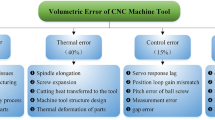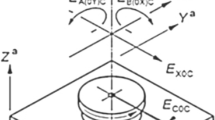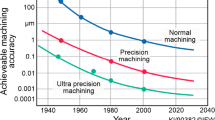Abstract
Trend of the high-speed and high efficiency machining has pushed the continuous demand of higher spindle speed and power for the machining center application. Because the extremely high speed produces significant centrifugal force, it creates a need to predict the spindle dynamical characteristics at dynamic states. This work presents analysis results of the spindle dynamic of a motorized high speed spindle with angular ball contact bearings. For a machining center, two major subsystems determining the overall spindle stiffness are the shaft/bearing subsystem and the draw bar mechanism subsystem. Shaft/bearing stiffness as well as the natural frequency decreased at high speeds due to the bearing softening and gyroscopic effect. The bearing softening is the major reason of the reduced spindle stiffness, while the gyroscopic effect plays the secondary effect. Angular contact ball bearing softening at high speed is due to the reduced contact load and increased contact angle at the ball/inner-raceway contact interface caused by the centrifugal force. For the draw bar mechanism, analysis results show that the dynamic draw force at high speeds is significantly increased from that designed at the static state. Because the toolholder/spindle interface stiffness is proportional to the draw force, centrifugal force theoretically contributes a plus to the spindle stiffness at dynamic state. The dynamic draw force, however, is dependent on the friction loss inside the draw bar mechanism. Because of the low friction coefficient, the ball-type mechanism is superior to the wedge type mechanism.
Similar content being viewed by others
References
Weck M, Koch A (1993) Spindle-bearing systems for high-speed applications in machine tools. Ann CIRP 42:1
Schulz H (1992) High-speed machining. Ann CIRP 41:2
Voll H, Ramer P, Schulz H, Schall D (1999) On the way to a new generation of spindles. Proc 1999 Sino-German Joint Symposium on High-Speed and High Precision Machining, 15–16 March 1999, pp 45–53
Tsutsumi M, Chung IS, Murakami Y, Ito Y (1985) Dynamic characteristics of spindle-bearing system in machine tools. Bulletin of JSME 28(244):2460–2466
Al-Shareef KJH, Bradon JA (1990) On the effects of variations in the design parameters on the dynamic performance of machine tool spindle-bearing system. Int J Mach Tool Manuf 30:431–445
Weck M, Hennes N, Krell M (1999) Spindle and toolsystems with high damping. Ann CIRP 48(1):297–302
Smith S, Jacobs TP, Halley J (1999) The effect of drawbar force on metal removal rate in milling. Ann CIRP 48(1):293–296
Weck M, Schubert I (1994) New interface machine/tool: hollow shank. Ann CIRP 43(1):345–348
Agapiou J, Rivin E, Xie C (1995) Toolholder/spindle interfaces for CNC machine tools. Ann CIRP 44(1):383–387
Tlusty J, Livingston R, Teng YB (1986) Nonlinearites in spindle bearings and their effect. Ann CIRP 35(1):269–273
Soon MP, Stone BJ (1998) The stiffness of stability indeterminate spindle systems with nonlinear bearings. Int J Adv Manuf Technol 14:787–794
Shin YC (1992) Bearing nonlinearity and stability analysis in high speed machining. Trans ASME J Eng Ind 114:23–30
Stein JL, Tu JF (1996) A state-space model for monitoring thermally induced preload in anti-friction spindle bearings of high-speed machine tools. Trans ASME J Dyn Syst Measure Control 116:372–386
Li H, Shin YC (2004) Analysis of bearing configuration effects on high speed spindles using an integrated dynamic thermo-mechanical spindle model. Int J Mach Tools Manuf 44:347–364
Lin C-W, Tu J, Kamman J (2003) An integrated thermo-mechanical-dynamic model to characterize machine tool spindles during very high speed rotation. Int J Mach Tools Manuf 43:1035–1050
Riven E (1993) Influence of toolholder interfaces on tooling performance. Trans NAMRI/SME 21:173–179
Aoyama T, Inasake I (2001) Performances of HSK tool interfaces under high rotational speed. Ann CIRP 50(1):280–284
Lin CC (1999) The development of a high speed spindle for machining center. Technical Report, National Chung Cheng University, NSC grant No. 86-2622-E-194-001R
Smith S, Jacobs TP, Halley J (1999) The effect of drawbar force on metal removal rate in milling. Ann CIRP 48(1):293–296
Chen JS, Chen KW (in press) Bearing Load Analysis and Control of a Motorized High Speed Spindle. Int J Mach Tool Manuf
Harris TA (2001) Rolling bearing analysis. Wiley, New York
Sykora H (1997) Training for OTT-JAKOB power drawbar systems. OTT-JAKOB Spanntechnik
Erickson R (2001) Tooling and taper interface considertios for high speed machining. High Speed Machining Workshop, 6 Nov 2001
Author information
Authors and Affiliations
Corresponding author
Rights and permissions
About this article
Cite this article
Chen, JS., Hwang, YW. Centrifugal force induced dynamics of a motorized high-speed spindle. Int J Adv Manuf Technol 30, 10–19 (2006). https://doi.org/10.1007/s00170-005-0032-y
Received:
Accepted:
Published:
Issue Date:
DOI: https://doi.org/10.1007/s00170-005-0032-y




